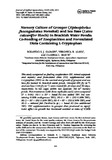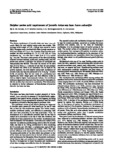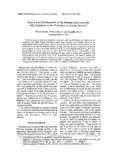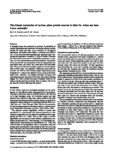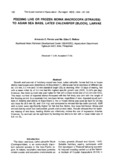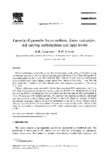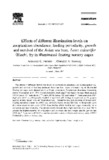Search
Now showing items 1-10 of 22
Daily amount of rotifers taken by a sea bass Lates calcarifer larvae
(Science and Technology Information Institute, 1990)
The amount of rotifers consumed by a single sea bass Lates calcarifer larva per day (R) was examined by both the direct and by the satiation-digestion methods. In the direct method, R is estimated by the number of rotifers ...
Nursery culture of grouper (Epinephelus fuscoguttatus Forsskal) and sea bass (Lates calcarifer Bloch) in brackish water ponds: Co-feeding of zooplankton and formulated diets containing L-tryptophan
(Taylor & Francis, 2012)
This study compared co-feeding zooplankton (ZP, mixed copepods and mysids) and formulated diets (FD) supplemented with L-tryptophan (TRP) on the survival and growth of grouper and sea bass fry nursed in brackish water ...
Sulphur amino acid requirement of juvenile Asian sea bass Lates calcarifer
(John Wiley and Sons, 1999)
The dietary requirement of juvenile Asian sea bass Lates calcarifer for total sulphur amino acids was studied. Fish (average initial weight of 2.59 plus or minus 0.08 g) were reared in twelve 500 L fibreglass tanks provided ...
Early larval development of the seabass Lates calcarifer with emphasis on the transition of energy sources
(Japanese Society of Fisheries Science, 1986)
The early growth, yolk and oil globule resorption, early morphological and behavioral de-velopment, and initial feeding of hatchery-raised Lates calcarifer were studied. Based on the developmental events and the energy the ...
Nutritional evaluation of various plant protein sources in diets for Asian sea bass Lates calcarifer
(Wiley-Blackwell, 2000)
A biological assay was conducted to evaluate the suitability of various leguminous seed meals and leaf meals as dietary protein sources for Asian sea bass, Lates calcarifer. In the growth experiment, fish (initial mean ...
An incidence of swimbladder stress syndrome in hatchery-reared sea bass (Lates calcarifer) larvae
(Elsevier, 1986)
This paper describes an incidence of swimbladder malfunction causing high positive buoyancy and mass mortality in 2-week-old sea bass (Lates calcarifer) larvae reared in an outdoor hatchery tank under conditions of high ...
Feeding live or frozen Moina macrocopa (Strauss) to Asian sea bass, Lates calcarifer (Bloch), larvae
(Society of Israeli Aquaculture and Marine Biotechnology, 1994)
Growth and survival of hatchery-reared sea bass, Lates calcarifer, larvae fed live or frozen Moina macrocopa were determined, In Experiment 1, Moina was fed to sea bass of different sizes: 3.6 mm, 5.5 mm and 7.6 mm standard ...
Growth of juvenile Asian seabass, Lates calcarifer, fed varying carbohydrate and lipid levels
(Elsevier, 1997)
Growth performance of juvenile seabass (initial mean body weight, 0.90 ± 0.04 g) fed varying carbohydrate and lipid levels were determined using practical diets in a 2 × 3 factorial experiment. Two carbohydrate levels (15 ...
Effects of different illumination levels on zooplankton abundance, feeding periodicity, growth and survival of the Asian sea bass, Lates calcarifer (Bloch), fry in illuminated floating nursery cages
(Elsevier, 1997)
The effects of different illumination levels on Zooplankton abundance and feeding periodicity, growth and survival of hatchery-produced Asian sea bass, Lates calcarifer, fry in illuminated floating net cages were determined ...
Netcage rearing of the Asian seabass Lates calcarifer (Bloch) in brackishwater pond: The technical and economic efficiency of using high protein diets in fingerling production
(College of Agriculture, University of the Philippines Los Baños, 2012)
Intensification in the grow-out culture of high-value fish requires a large quantity of quality fingerlings. Fingerling production is a component of fish farming that comprises nursery and grow-out culture, and may be a ...


